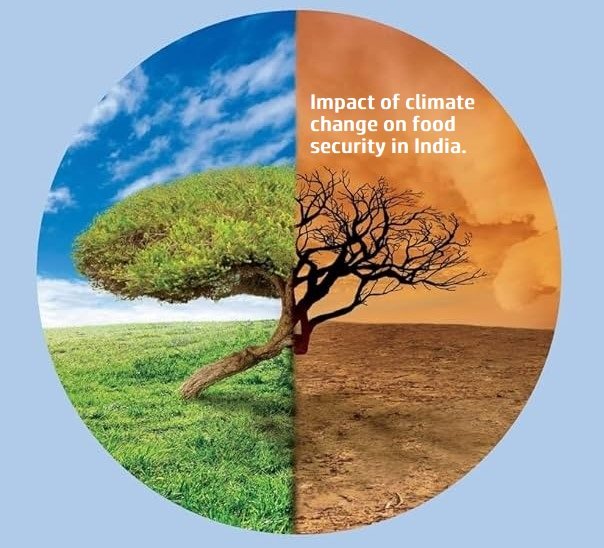AWIP, Economics, Environment & Ecology, Geography
Q. Discuss the impact of climate change on food security in India.
Climate change significantly impacts food security in India, a country heavily reliant on agriculture for livelihoods and sustenance. The effects are multifaceted, influencing agricultural productivity, water resources, and socio-economic conditions. Here’s a detailed discussion of the impact of climate change on food security in India:
Agricultural Productivity
- Temperature Changes:
- Heat Stress: Rising temperatures can cause heat stress in crops, reducing yields of staples like wheat and rice. High temperatures during critical growth periods can lead to crop failure that adversely affects food security. For every 1% increase in temperature, food security decreases by 1.2% in the short run and 1.7% in the long run.
- Altered Growing Seasons: Changes in temperature patterns can disrupt traditional planting and harvesting cycles, affecting crop productivity and planning.
- Precipitation Variability:
- Erratic Rainfall: Increased variability in rainfall patterns leads to droughts and floods, both of which adversely affect crop yields. The unpredictability makes it difficult for farmers to plan and manage their crops effectively.
- Monsoon Dependence: Indian agriculture is highly dependent on the monsoon season. Changes in monsoon patterns can lead to insufficient or excessive rainfall, impacting crop health and productivity.
Extreme Weather Events:
- Cyclones and Storms: Increased frequency and intensity of extreme weather events, such as cyclones and storms, can cause widespread damage to crops and agricultural infrastructure.
- Flooding: Flooding can destroy crops, erode soil, and lead to long-term degradation of agricultural land.
- Droughts cause crop failures, leading to food scarcity and insecurity.
Water Resources
- Water Scarcity:
- Reduced Water Availability: Climate change affects the availability of water for irrigation due to decreased rainfall and shrinking glaciers, which are crucial sources for many rivers in India.
- Groundwater Depletion: Increased reliance on groundwater due to erratic rainfall leads to over-extraction, reducing water availability for future agricultural use.
- Irrigation Challenges:
- Irrigation Infrastructure: Changes in water availability strain existing irrigation systems, which may not be equipped to handle new patterns of water supply and demand.
- Competition for Water: Agriculture competes with other sectors for limited water resources, intensifying during periods of scarcity.
Soil Health
- Soil Degradation:
- Erosion: Extreme weather events and deforestation contribute to soil erosion, reducing the land’s productivity.
- Salinization: Rising sea levels and excessive irrigation can lead to soil salinization, rendering soil unfit for agriculture.
- Nutrient Loss:
- Soil Fertility: Climate-induced changes can affect soil fertility, making it harder for crops to access essential nutrients.
Livestock and Fisheries
- Livestock:
- Heat Stress: Rising temperatures can affect livestock health, reducing productivity in terms of milk and meat production.
- Feed and Water Shortages: Drought conditions can lead to shortages of feed and water for livestock, impacting their survival and productivity.
- Fisheries:
- Marine Ecosystems: Changes in sea temperatures and acidification affect marine biodiversity and fish populations, impacting coastal communities reliant on fishing.
- Inland Fisheries: Alterations in freshwater ecosystems due to changing precipitation patterns can affect inland fishery production.
Socio-Economic Impacts
- Rural Livelihoods:
- Farmer Distress: Reduced agricultural productivity leads to financial distress among farmers, increasing incidents of debt and poverty.
- Migration: Poor agricultural conditions can drive rural populations to migrate to urban areas, leading to urban overcrowding and increased pressure on urban infrastructure and services.
- Food Prices and Accessibility:
- Price Volatility: Reduced agricultural output can lead to increased food prices, making it difficult for low-income households to afford nutritious food.
- Food Distribution: Disruptions in production can affect the supply chain, leading to food shortages in certain regions.
Health and Nutrition
- Malnutrition:
- Food Availability: Reduced food production can lead to shortages, affecting food availability and contributing to malnutrition, especially among vulnerable populations.
- Diet Quality: Economic constraints and food scarcity can force households to shift to less nutritious diets, exacerbating health issues related to poor nutrition.
- Population Growth:
-
- Population growth negatively impacts food security.
- A 1% increase in population leads to a decline of 3.8% in the short run and 7.8% in the long run.
Conclusion
The impact of climate change on food security in India is profound, affecting agricultural productivity, water resources, soil health, livestock, and fisheries, with significant socio-economic and health implications. Addressing these challenges requires a multifaceted approach, including the development of climate-resilient agricultural practices, efficient water management strategies, soil conservation techniques, and social safety nets to protect vulnerable populations. Policymakers, researchers, and communities must work together to develop adaptive strategies that ensure sustainable food security in the face of a changing climate.
…………………………………………………………………………………………………………………………………………………………………………………
Sustainable Strategies:
- Expanding cultivation areas for food crops enhances food security.
- Effective agricultural subsidies (like fertilizer subsidies) play a key role in the short run but have adverse effects in the long run.
- Sustainable land management, temperature control measures, and water reservation are crucial.


